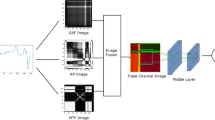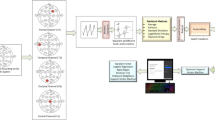Abstract
The Electrocardiogram (ECG) signal processing is one of the exciting research areas in recent days. Ensuring security to the patient’s confidential information is a demanding critical task in many healthcare systems. So, the traditional works developed the security mechanisms for embedding the original ECG signal with the image, audio, or video. But, it does not focus on reducing the size of the original message before transmitting it to others. Also, it has significant limitations of inefficient security, increased complexity, and reduced classification accuracy. To rectify this issue, our research proposed the new embedding mechanism to improve the security of patient’s health information. In this system, the original ECG signals compressed at the initial stage by using the proposed Dictionary Matrix Generation (DMG) algorithm. Then, the compressed signals embedded within the cover image by using the Bitwise Embedding (BE) mechanism. At the receiver side, the bedded goal is de-embedded and decompressed by using the DMG and BE algorithms. The features such as spectral and peak values of the signal are extracted for increasing the efficiency of classification. Classification and detection of abnormality present in ECG signal of patient is the most essential part. To achieve this, we proposed the Modified Dynamic Classification (MDC) algorithm based on the features. In this work, the novelty is implemented in the compression, embedding, and classification stages. The proposed system reduces the data loss during transmission, memory storage and time complexity. The overall process evaluated by using PTB diagnostic ECG database. In experiments, the proposed classification technique provides the accuracy of 98.39% and it proved that the proposed method had highest performances than existing methods such as PNN, SVM and RF classification.








Similar content being viewed by others
References
Abdulla AA (2015) Exploiting similarities between secret and cover images for improved embedding efficiency and security in digital steganography. University of Buckingham, Buckingham
Abdulla AA, Sellahewa H, Jassim SA (2014) Stego quality enhancement by message size reduction and fibonacci bit-plane mapping. International Conference on Research in Security Standardisation:151–166
Al Rahhal MM, Bazi Y, AlHichri H, Alajlan N, Melgani F, Yager RR (2016) Deep learning approach for active classification of electrocardiogram signals. Inf Sci 345:340–354
Ardan A, Ma’arif M, Aisyah Z, Olivia M, Titin S (2019) Myocardial infarction detection system from PTB diagnostic ECG database using Fuzzy inference system for ST waves. J Phys Conf Ser:012071
Awasthi D, Madhe S (2015) Evaluation of wavelet based ECG steganography system by using Percentage Residual Difference (PRD) measurements. in Communications and Signal Processing (ICCSP), 2015 International Conference on, pp. 0559–0563.
Awasthi D, Madhe S (2015) Analysis of encrypted ECG signal in steganography using wavelet transforms. in Electronics and Communication Systems (ICECS), 2015 2nd International Conference on, pp. 718–723.
Chen X, He F, Yu H (2019) A matting method based on full feature coverage. Multimed Tools Appl 78:11173–11201
Cheng L-T, Yang C-Y (2018) High performance electrocardiogram steganography based on fast discrete cosine transform. International Journal of Computer and Information Engineering 12:509–514
Chowdhury M, Poudel K, Hu Y (2018) Phonocardiography Data Compression Using Discrete Wavelet Transform," 2018 IEEE Signal Processing in Medicine and Biology Symposium (SPMB), pp. 01–03.
Cuadros J, Dugarte N, Wong S, Vanegas P, Morocho V, Medina R (2019) ECG multilead QT interval estimation using support vector machines. Journal of healthcare engineering, vol 2019
Denemark T, Fridrich J (2017) Steganography with multiple JPEG images of the same scene. IEEE Transactions on Information Forensics and Security
Feng N, Xu S, Liang Y, Liu K (2019) A probabilistic process neural network and its application in ECG classification. IEEE Access 7:50431–50439
Ghasemzadeh H, Khass MT, Arjmandi MK (2016) Audio steganalysis based on reversed psychoacoustic model of human hearing. Digital signal processing 51:133–141
Haddadi R, Abdelmounim E, El Hanine M, Belaguid A (2019) A wavelet-based ECG delineation and automated diagnosis of myocardial infarction in PTB database. in Third International Conference on Computing and Wireless Communication Systems, ICCWCS 2019
Holub V, Fridrich J (2015) Low-complexity features for JPEG steganalysis using undecimated DCT. IEEE Transactions on Information Forensics and Security 10:219–228
Hu Y-H, Li Y-H, Zhao M (2019) Integration of information hiding and compression for biomedical signals. Journal of Internet Technology 20:975–982
Ibaida A, Khalil I (2013) Wavelet-based ECG steganography for protecting patient confidential information in point-of-care systems. IEEE Trans Biomed Eng 60:3322–3330
Jero SE, Ramu P (2016) Curvelets-based ECG steganography for data security. Electron Lett 52(4), 283–285. Available: http://digital-library.theiet.org/content/journals/10.1049/el.2015.3218
Jha CK, Kolekar MH (2017) ECG data compression algorithm for tele-monitoring of cardiac patients. International Journal of Telemedicine and Clinical Practices 2:31–41
Jha CK, Kolekar MH (2019) Diagnostic quality assured ECG signal compression with selection of appropriate mother wavelet for minimal distortion. IET Sci Meas Technol 13:500–508
Jovanovic BD, Litovski VB, Pavlović M (2015) "QRS complex detection based ECG signal artefact discrimination," Facta Universitatis. Series: Electronics and Energetics 28:571–584
Li H, Liang H, Miao C, Cao L, Feng X, Tang C et al (2016) Novel ECG signal classification based on KICA nonlinear feature extraction. Circuits, Systems, and Signal Processing 35:1187–1197
Liji C, Indiradevi K, Babu KA (2016) Integer-to-integer wavelet transform based ECG steganography for securing patient confidential information. Procedia Technology 24:1039–1047
Marakarkandy B, Tiwari MR (2015) Secure Steganography, Compression and Transmission of ECG signal for Protecting Patient Confidential Information in Point-of-Care Systems. International Journal of Application or Innovation in Engineering & Management (IJAIEM) 4:94–99
Mathivanan P, Jero SE, Ramu P, Ganesh AB (2018) QR code based patient data protection in ECG steganography. Australasian physical & engineering sciences in medicine 41:1057–1068
Memos VA, Psannis KE, Ishibashi Y, Kim B-G, Gupta BB (2018) An efficient algorithm for media-based surveillance system (EAMSuS) in IoT smart city framework. Futur Gener Comput Syst 83:619–628
Meng R, Zhou Z, Cui Q, Sun X, Yuan C (2019) A novel steganography scheme combining coverless information hiding and steganography. Joural of Information Hiding and Privarcy Protection 1:43–48
Mohagheghi E, Gabash A, Li P (2017) A framework for real-time optimal power flow under wind energy penetration. Energies 10:535
Pasolli E, Melgani F (2015) Genetic algorithm-based method for mitigating label noise issue in ECG signal classification. Biomedical Signal Processing and Control 19:130–136
Patil V, Patil M (2018) Curvelet Based ECG Steganography for Protection of Data. in Computational Vision and Bio Inspired Computing, ed: Springer, pp. 238–248
Plageras AP, Psannis KE, Stergiou C, Wang H, Gupta BB (2018) Efficient IoT-based sensor BIG data collection–processing and analysis in smart buildings. Futur Gener Comput Syst 82:349–357
Psannis KE, Ishibashi Y (2006) Impact of video coding on delay and jitter in 3G wireless video multicast services. EURASIP J Wirel Commun Netw 2006:024616
Rani R, Chouhan V, Sinha H (2015) Automated detection of qrs complex in ECG signal using wavelet transform. International Journal of Computer Science and Network Security (IJCSNS) 15:1
Reddy KG, Vijaya P, Suhasini S (2017) ECG Signal Characterization and Correlation To Heart Abnormalities. International Research Journal of Engineering and Technology (IRJET) 4:1212–1216
Sankari V, Nandhini K (2014) Steganography technique to secure patient confidential information using ECG signal. in Information Communication and Embedded Systems (ICICES), 2014 International Conference on, pp. 1–7
Stergiou C, Psannis KE, Kim B-G, Gupta B (2018) Secure integration of IoT and cloud computing. Futur Gener Comput Syst 78:964–975
Stergiou C, Psannis KE, Plageras AP, Ishibashi Y, Kim B-G (2018) Algorithms for efficient digital media transmission over IoT and cloud networking. Journal of Multimedia Information System 5:27–34
Sulam J, Romano Y, Talmon R (2017) Dynamical system classification with diffusion embedding for ECG-based person identification. Signal Process 130:403–411
Świerkosz A, Augustyniak P (2018) Optimizing wavelet ECG watermarking to maintain measurement performance according to industrial standard. Sensors 18:3401
(2017). The PTB Diagnostic ECG Database. Available: https://www.physionet.org/physiobank/database/ptbdb/
Tsai T-H, Kuo W-T (2018) An efficient ECG lossless compression system for embedded platforms with telemedicine applications. IEEE Access 6:42207–42215
Wang Z, Qian L, Han C, Shi L (2020) Application of multi-feature fusion and random forests to the automated detection of myocardial infarction. Cogn Syst Res 59:15–26
Wu F, Jing X-Y, You X, Yue D, Hu R, Yang J-Y (2016) Multi-view low-rank dictionary learning for image classification. Pattern Recogn 50:143–154
Wu F, Jing X-Y, Yue D (2017) Multi-view discriminant dictionary learning via learning view-specific and shared structured dictionaries for image classification. Neural Process Lett 45:649–666
Wu F, Jing X-Y, Zuo W, Wang R, Zhu X (2017) Discriminant tensor dictionary learning with neighbor uncorrelation for image set based classification. in Proceedings of the 26th International Joint Conference on Artificial Intelligence, pp. 3069–3075.
Wu W, Liu B, Zhang W, Chen C (2015) Reversible data hiding in ECG signals based on histogram shifting and thresholding," in Future Information and Communication Technologies for Ubiquitous HealthCare (Ubi-HealthTech), 2015 2nd International Symposium on, pp. 1–5.
Yildirim O, San Tan R, Acharya UR (2018) An efficient compression of ECG signals using deep convolutional autoencoders. Cogn Syst Res 52:198–211
Yu H, He F, Pan Y (2018) A novel region-based active contour model via local patch similarity measure for image segmentation. Multimed Tools Appl 77:24097–24119
Yu H, He F, Pan Y (2019) A novel segmentation model for medical images with intensity inhomogeneity based on adaptive perturbation. Multimed Tools Appl 78:11779–11798
Zhang S, He F, Ren W, Yao J (2018) Joint learning of image detail and transmission map for single image dehazing. Vis Comput:1–12
Author information
Authors and Affiliations
Corresponding author
Additional information
Publisher’s note
Springer Nature remains neutral with regard to jurisdictional claims in published maps and institutional affiliations.
Rights and permissions
About this article
Cite this article
Atal, D.K., Singh, M. A dictionary matrix generation based compression and bitwise embedding mechanisms for ECG signal classification. Multimed Tools Appl 79, 13139–13159 (2020). https://doi.org/10.1007/s11042-020-08671-6
Received:
Revised:
Accepted:
Published:
Issue Date:
DOI: https://doi.org/10.1007/s11042-020-08671-6




